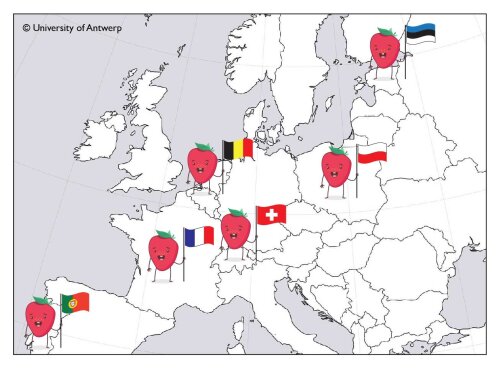StrawbAIRies Europe
In the scope of the European BIOVEINS project (BiodivERsA – Horizon2020) we will repeat this groundbreaking citizen science project in a unique trans-European setting. We will monitor traffic-related air quality in urban environments by means of the strawberry plant, distributed to and treated by volunteering citizens. In addition – and new in this project - is that we will assess the pollination success of plants in urban environments in relation to air pollution and the availability of green in the neighbourhood. Therefore we will use the bird’s-foot trefoil next to the strawberry plants.
BIOVEINS is a collaboration between 7 Universities in 6 European countries. The partners in this strawbAIRies project are:
- Antwerp, Belgium, The lab of Environmental and Urban Ecology, University of Antwerp;
- Lisbon, Portugal, cE3c, Centre for Ecology, Evolution and Environmental Changes, Faculdade de Ciências da Universidade de Lisboa.
- Paris, France, Université Paris Sud, Orsay, UMR 8079 Écologie, Systématique, Évolution;
- Poznan, Poland, Institute of Zoology, Poznan University of Life Sciences;
- Tartu, Estonia, Estonian University of Life Sciences, Institute of Agricultural and Environmental Sciences; and
- Zürich, Switzerland, Swiss Federal Research Institute WSL, Biodiversity and Conservation Biology.

These cities were previously selected because they are located on a North-East to South-West line through Europe, covering different climate zones.
In this strawbAIRies project, not only strawberry (Fragaria sp.) plants but also bird's-foot trefoil (Lotus corniculatus var. Leo) will be used. Each participating citizen will be provided with one plant of each species. As each plant is potted separately, each selected citizen will receive two pots. Plants will be set out and cared for by the citizens for two months in spring-summer 2019. During this period, citizens will follow-up the amount, size and shape of berries for the strawberry plant and count and collect all pods for the bird’s-foot trefoil plant. These observations can be entered immediately into the project website. After this two month period, five predetermined leaves of every plant will be collected by the citizens. Moreover, of the bird’s-foot trefoil also the pods will be sampled. The samples (pods and leaves) will be collected by the local partners and subsequently sent to Antwerp for further analysis. First preliminary results are expected for November 2019. All citizens who expressed their interest for the project will receive information on their plants, in relation to their home city, and in relation to the other participating countries.